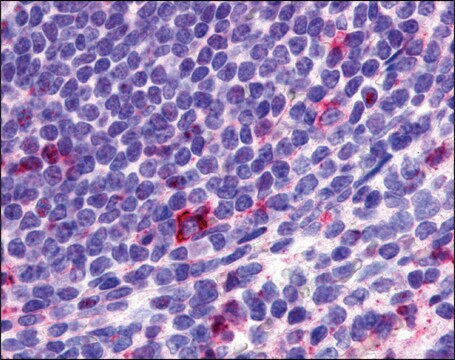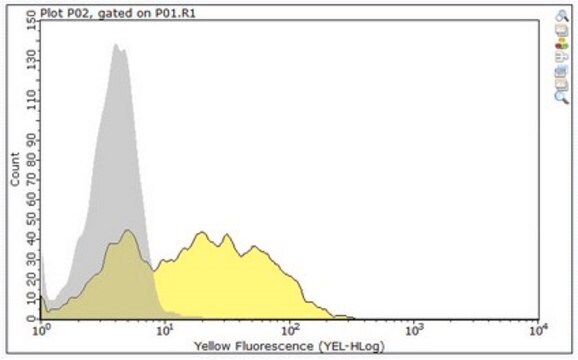General description
We are committed to bringing you greener alternative products, which adhere to one or more of The 12 Principles of Green Chemistry.This antibody is Preservative-free, produced without the harm or sacrifice of animals and exceptionally stable to allow for ambient shipping and storage if needed and thus aligns with "Waste Prevention", "Designing Safer Chemicals" and "Design for Energy Efficiency".
Click here for more information.
ZooMAb® antibodies represent an entirely new generation of recombinant monoclonal antibodies.Each ZooMAb® antibody is manufactured using our proprietary recombinant expression system, purified to homogeneity, and precisely dispensed to produce robust and highly reproducible lot-to-lot consistency. Only top-performing clones are released for use by researchers. Each antibody is validated for high specificity and affinity across multiple applications, including its most commonly used application. ZooMAb® antibodies are reliably available and ready to ship when you need them.
Specificity
Clone 5K5-3 is a ZooMAb® Rabbit recombinant monoclonal antibody that specifically detects C-C chemokine receptor type 2 (CCR2). It targets an epitope within the first extracellular domain in the N-terminal region.
Immunogen
GST-tagged recombinant fragment corresponding to first 42 amino acids from the first extracellular domain from the N-terminal region of human C-C chemokine receptor type 2 (CCR2).
Application
Quality Control Testing
Evaluated by Western Blotting in NIH3T3 cell lysate.
Western Blotting Analysis: A 1:1,000 dilution of this antibody detected CCR2 in NIH3T3 cell lysate.
Tested applications
Western Blotting Analysis: A 1:1,000 dilution from a representative lot detected CCR2 in THP-1 cell lysate.
Immunohistochemistry (Paraffin) Analysis: A 1:100 dilution from a representative lot detected CCR2 in human tonsil tissue sections.
Flow Cytometry Analysis: 0.1 μg from a representative lot detected CCR2 in one million U937 cells.
Affinity Binding Assay: A representative lot of this antibody bound CCR2 with a KD of 6.3 x 10-11 in an affinity binding assay.
Note: Actual optimal working dilutions must be determined by end user as specimens, and experimental conditions may vary with the end user
Anti-CCR2, clone 5K5-3 ZooMAb®, Cat. No. ZRB2027, is a recombinant Rabbit monoclonal antibody that specifically targets CCR2 and is tested for use in Affinity Binding Assay, Flow Cytometry, Immunohistochemistry (Paraffin), and Western Blotting.
Target description
C-C chemokine receptor type 2 (UniProt: P41597; also known as C-C CKR-2, CC-CKR-2, CCR-2, CCR2, Monocyte chemoattractant protein 1 receptor, MCP-1-R, CD192) is encoded by the CCR2 (also known as CMK BR2) gene (Gene ID: 729230) in human. Chemokine receptors are 7-transmembrane G protein-coupled receptors that bind CC chemokines (CCL) and mediate their biological activities. They play a key role in physiological and pathological recruitment of immune cells. CCR2 is a multi-pass membrane protein with four extracellular domains, seven transmembrane domains, and four cytoplasmic domains. It is a functional receptor for CC chemokine 2 (CCL2) but can also bind CCL7 and CCL12. Its binding with CCL2 on monocytes and macrophages mediates chemotaxis and migration induction through the activation of the PI3 Kinase cascade and the small G protein Rac. CCR2 is reported to regulate the expression of T-cell inflammatory cytokines and is involved in T-cell differentiation, promoting the differentiation of T-cells into T-helper 17 cells during inflammation. It also facilitates the export of mature thymocytes by enhancing directional movement of thymocytes to sphingosine-1-phosphate stimulation and up-regulation of S1P1R expression. CCR2 can also mediate the recruitment of macrophages and monocytes to the injury site in the brain. CCR2-knockout mice show a partial defect in macrophage function, decreased Th1 immune response, reduced delayed-type hypersensitivity reaction, and are more susceptible to pathogenic bacteria infections. CCR2 can undergo sulfation that increases its affinity for both monomeric and dimeric CCL2 . Binding of the sulfated CCR2 to CCL2 promotes the conversion of CCL2 from dimer to monomer. This ZooMAb® recombinant monoclonal antibody, generated by our propriety technology, offers significantly enhanced specificity, affinity, reproducibility, and stability over conventional monoclonals.
Physical form
Purified recombinant rabbit monoclonal antibody IgG, lyophilized in PBS with 5% Trehalose, normal appearance a coarse or translucent resin. The PBS/trehalose components in the ZooMAb® formulation can have the appearance of a semi-solid (bead like gel) after lyophilization. This is a normal phenomenon. Please follow the recommended reconstitution procedure in the data sheet to dissolve the semi-solid, bead-like, gel-appearing material. The resulting antibody solution is completely stable and functional as proven by full functional testing. Contains no biocide or preservatives, such as azide, or any animal by-products. Larger pack sizes provided as multiples of 25 μL.
Reconstitution
300 μg/mL after reconstitution at 25 μL per vial. Please refer to guidance on suggested starting dilutions and/or titers per application and sample type.
Storage and Stability
Recommend storage of lyophilized product at 2-8°C; Before reconstitution, micro-centrifuge vials briefly to spin down material to bottom of the vial; Reconstitute each vial by adding 25 μL of filtered lab grade water or PBS; Reconstituted antibodies can be stored at 2-8°C, or -20°C for long term storage. Avoid repeated freeze-thaws.
Legal Information
ZooMAb is a registered trademark of Merck KGaA, Darmstadt, Germany
Disclaimer
Unless otherwise stated in our catalog or other company documentation accompanying the product(s), our products are intended for research use only and are not to be used for any other purpose, which includes but is not limited to, unauthorized commercial uses, in vitro diagnostic uses, ex vivo or in vivo therapeutic uses or any type of consumption or application to humans or animals.










